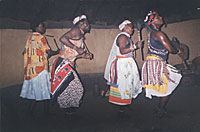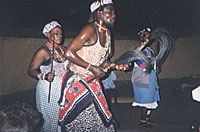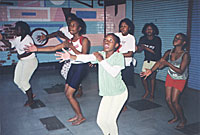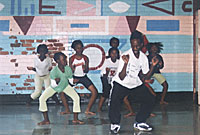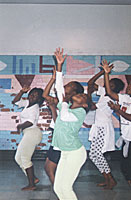There are not many countries worldwide with a wider gap between the rich and poor, as in South Africa. The testimony of more than 50 years of Apartheid is perceptible everywhere and still visible in many places. South Africa still has a long way to go, to become a democratic nation with the same chances/opportunities and respect for all its citizens. Especially since, the financial and economic resources are almost still under the control of the white minority. The education of the poor black African communities is often only very basic and illiteracy is far too high. At the same time one can find a very well educated upper class in big cities. A small group of professionally and economically successful black and coloured people were able to benefit at the end of Apartheid. The huge majority of the non-white population still live in the Apartheid system designed "Townships" and who have no proper job and no real perspectives.
Amongst many others artists too, are trying to contribute something to overcome the big differences between rich and poor, black and white. The official and nationally supported cultural life during the Apartheid years was in fact European or American culture and mostly white artists were performing for a white audience. But there was and is, for many years an African (black) underground culture scene that was sometimes internationally very successful (e.g. musical "Sarafina"). South Africa has both, a strong European as well as an African cultural life and tradition. These are the base of a very interesting and sometimes explosive mixture that is searching for an artistic expression of the gap between a highly developed consumer's world and the traditional life of African communities and their rituals.
The "dance city" in South Africa is Johannesburg. An important number of dancers and choreographers are living in Johannesburg. It is also the home of the annual Dance Umbrella Festival, which shows new work of South African choreographers and also invites international companies. Johannesburg is one of the most dangerous cities in the world. It consists of so many different neighbourhoods like downtown Johannesburg, the business centre, all around, you find everything in the range of Soweto (South Western Township); a ocean of so called "matchbox houses" and Sandton where the upper class hang out in huge shopping malls. This enormous differences between poor and rich create extreme tension. It is on the one hand the reason for the exorbitant high criminal rates but on the other hand it is expressed through the cultural life of the city.
One of the most important supporters of young black dancers and choreographers is the company "Moving into Dance". Sylvia Magogo Glasser founded it in 1978 as "non-racial" dance company. Through the years they developed their unique "Afro-Fusion" stile. The company tours world-wide and is currently directed by Vincent Sekwati Koko Mantsoe, one of the most talented choreographer's in South Africa.
Almost all the companies, dancers and choreographers are involved in volunteer work (mostly teaching and performing in less privileged communities). Established companies like Moving into Dance, Soweto Dance Theatre, and Ballet Theatre Afrikan in Johannesburg or Jazzart in Cape Town, most of them founded during Apartheid years by white choreographers and teachers have similar structures. They are active on three levels:
- The professional dance company is performing in and outside South Africa. All the time keeping a high technical and artistic level and keeping itself remarked throughout their home cities.
- Each company offers a training program, sometimes a real dance formation. It is providing young dancers for the company. At the same time they give many poor and less privileged children the possibility of learning and spending their free time in an intelligent way. The support of those young dancers goes often far beyond dance training. The Cape Town based company Jazzart (director: Alfred Hinkel) provides with a small scholarship, for company members with a regular salary, basic skills and support for every day life, helps them to find a accommodation outside the townships, offered life skills training that enhances their health and eating habits. Many companies offer repetition lessons in reading, writing, English and mathematics. 200 young boys and girls between 14 and 17 applied at the last audition of Jazzart to be part of the dance formation program. 15 of them are accepted.
- The companies also teach dance classes in less-privileged communities. Normally company members visit Townships regularly. They are trained to pass on the information and knowledge they gained through their own training. The companies try to multiply their work and let the highest possible number of people profit from it.
An example is the Ballet Theatre Afrikan (director: Martin Schoenberg). This company focussed more on ballet training. The company's repertory consists of ballet and modern dance pieces.
The Soweto Dance Theatre with Jackie Semela-director, teaches children every evening in a small studio at the YMCA Orlando in Soweto for the last 18 years, free of charge. Many of the young black dancers in Johannesburg discovered their passion for dance attending those classes. From time to time the police forces of the Apartheid authorities would arrest young people during the dance classes because at that time assemblies of more than three people were not allowed. On this quiet evening in May during my visit there were about 10 girls in the class. They were dancing with all of their hearts for 90 minutes having an attentive audience observing them in the studio and through the windows.
Like in Europe the young generation of dancers and choreographers work in loose groups on project basis, for instance the two former P.A.R.T.S.-students Moeketsi Koena and George Khumalo. Their work is more oriented on Release Technique, contemporary dance and Contact Improvisation. The established companies I mentioned before, were generally technically more inspired by American Modern Dance especially Alvin Ailey. The exchange between dancers and choreographers of different African countries and Europe is increasing. Moeketsi Koena is working on a new piece about AIDS in collaboration with a dancer from Madagascar and an actress from France. This summer some pieces of two other young choreographer's Mandla Bebeza and Sello Pesa will be performed in La Rochelle and Amsterdam. Many of the young choreographers are experimenting with video, music and spaces. They deconstruct and reduce the traditional African movement repertory. Partnering work is more and more integrated. Streetdance and HipHop elements are introduced. Professional dancers work crossover with other artists, actors and often with amateurs.
Whatever I was able to see in rehearsals was without exception of high artistic and technical quality and always amazingly performed. Over all the dance creations these days stays an honest and strong engagement for political and social problems in South Africa and a vision of a society with equal opportunities for everybody.
Not only the big companies provide formation for young dancers but also some Universities in South Africa have renewed their dance studies in the last few years. During Apartheid they were mostly Ballet schools. Now different dance degrees are offered on their programs and there is also research on dance. At the Cape Town University, School of Dance choices can be made between three degree programs: ballet, Modern Dance and since 1998 African dance. Combined studies in dance and cultural anthropology are quite common. For a long time suppressed African culture becomes an important issue of research programs. And there is no time to loose; African traditional culture is changing and disappearing very fast in this modern world. Nowadays in South Africa, this research is done by young Africans who are looking at their own culture and with the colonialist point of view of a foreign scientist. One of those is Maxwell Xolani Rani. He was the first student to receive a degree in African dance at Cape Town University. Now he is not only teaching at the University but he is doing research on the traditional dances of South Africa.
“The integration, through dance and teacher training, of people from different cultural backgrounds and abilities. The promotion of dance education and performance opportunities in historically disadvantaged communities. The integration of African dance, music and ritual with Western dance culture. A creative and holistic learning process, which links the mind, body and spirit through movement. Dance as a means of integrating the worlds of Arts and Science and is sensitive to and responds to the needs of the community.” (Moving into Dance)
Information:
- Pro Helvetia, Liaison Office Cape Town
- University of Cape Town
- Dance Company Jazzart, Cape Town
- Dance Umbrella Johannesburg
Bettina Holzhausen, June 2002

